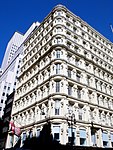2023 New York City parking garage collapse
2020s in Manhattan2023 disasters in the United States2023 in New York CityApril 2023 events in the United StatesBuilding collapses in 2023 ... and 6 more
Building collapses in the United StatesDisasters in New York CityFinancial District, ManhattanPace UniversityUse American English from April 2023Use mdy dates from April 2023
A parking garage building partially collapsed in the Financial District of Manhattan in New York City, United States, on April 18, 2023, resulting in one death, five injuries and the evacuation of neighboring buildings.
Excerpt from the Wikipedia article 2023 New York City parking garage collapse (License: CC BY-SA 3.0, Authors).2023 New York City parking garage collapse
Ann Street, New York Manhattan
Geographical coordinates (GPS) Address Nearby Places Show on map
Geographical coordinates (GPS)
| Latitude | Longitude |
|---|---|
| N 40.71046 ° | E -74.00641 ° |
Address
Enterprise Ann Parking
Ann Street
10038 New York, Manhattan
New York, United States
Open on Google Maps










